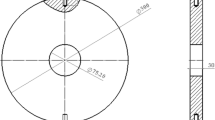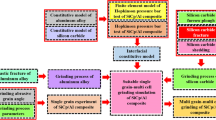Abstract
Grinding is the main processing technique for particle-reinforced composites, in which grinding force and temperature are significant for investigating the removal mechanism and surface properties. In this study, a grinding force prediction model is established based on the response surface methodology. The energy density of surface heat source in the grinding area is calculated by combining the contact area between the grinding wheel and workpiece. Based on the integration algorithm in time and space, a theoretical ideal grinding temperature prediction model is deduced. The grinding heat energy transfer coefficient is defined as the percentage of heat energy, which is transferred from the grinding heat energy to the workpiece. According to the experimental and ideal theoretical highest grinding temperatures, a prediction model of the heat energy transfer coefficient is established, and the modified theoretical highest grinding temperature prediction model is obtained. Furthermore, a finite element model of SiCp/Al composite in grinding is established. The highest grinding temperature in the finite element model is consistent with the modified theoretical highest grinding temperature, and the grinding temperature field is analysed. The highest grinding temperature increases as the wheel speed and grinding depth increase, while it decreases as table speed increases, which differs from that of some common materials. Thus, the grinding temperature prediction model provides an important reference for the study of removal mechanism and surface properties of SiCp/Al composite.



















Similar content being viewed by others
References
Mao C, Liang C, Zhang Y et al (2017) Grinding characteristics of CBN-WC-10Co composites[J]. Ceram Int 43:16539–16547
Shanawaz A, Sundaram S, Pillai U et al (2017) Grinding of aluminum silicon carbide metal matrix composite materials by electrolytic in-process dressing grinding[J]. Int J Adv Manuf Technol 57:143–150
Huang S, Yu X (2017) A study of grinding forces of SiCp/Al composites[J]. Int J Adv Manuf Technol 4:1–7
Sun J, Qin F, Chen P et al (2016) A predictive model of grinding force in silicon wafer self-rotating grinding[J]. Int J Mach Tool Manu 109:74–86
Li C, Zhang F, Meng B et al (2016) Material removal mechanism and grinding force modelling of ultrasonic vibration assisted grinding for SiC ceramics[J]. Ceram Int 43(3):2891–2993
Habrat W (2016) Effect of bond type and process parameters on grinding force components in grinding of cemented carbide [J]. Procedia Eng 149:122–129
Cao Y, Hua L, Xie O et al (2016) An experimental investigation of grinding force in ultrasonic vibration assisted internal grinding for SiC ceramics[C]. International Conference on Mechanics Design. In: Manufacturing and Automation (MDM)
Durgumahanti U, Singh V, Rao P (2010) A new model for grinding force prediction and analysis[J]. Int J Mach Tool Manu 50(3):231–240
Liu Q, Chen X, Wang Y et al (2008) Empirical modelling of grinding force based on multivariate analysis[J]. J Mater Process Technol 203(1):420–430
Lin B, Zhou K, Guo J et al (2018) Influence of grinding process parameters on surface temperature and burn behaviors of grinding rail[J]. Tribol Int 122:151–162
Yu H, Lyu Y, Wang J (2019) Experimental investigation on grinding temperature of Ti–6Al–4V using biomimetic engineered grinding wheel. Int J Precis Eng Manuf Green Technol 6:163–173
Liu G, Gong Y, Wang W (2006) Intelligent monitor and control system for grinding process[J]. Key Eng Mater 304-305:535–539
Chen T, Ye M, Liu S et al (2017) Measurement of ultrasonic assisted grinding temperature based on fiber Bragg grating (FBG) sensor[J]. Int J Adv Manuf Technol 93:2561–2570
Fukuhara Y, Suzuki S, Sasahara H (2018) Real-time grinding state discrimination strategy by use of monitor-embedded grinding wheels[J]. Precis Eng 51:128–136
Wang X, Yu T, Sun X et al (2016) Study of 3D grinding temperature field based on finite difference method: considering machining parameters and energy partition[J]. Int J Adv Manuf Technol 84:915–927
Pashnyov V, Pimenov D, Erdakov I et al (2017) Modeling and analysis of temperature distribution in the multilayer metal composite structures in grinding[J]. Int J Adv Manuf Technol 91:4055–4068
Zhu C, Gu P, Liu D et al (2019) Evaluation of surface topography of SiCp/Al composite in grinding[J]. Int J Adv Manuf Technol 102:2807–2821
Zhu C, Gu P, Wu Y et al (2019) Surface roughness prediction model of SiCp/Al composite in grinding[J]. Int J Mech Sci 155:98–109
Li B, Zhao B, Li Q (2015) Abrasives and grinding technology[M]. Chemical Industry Press, Beijing, pp 147–149
Ren J, Hua D (1988) Grinding principle [M]. Northwestern Polytechnical University Press, Xian, pp 54–70
Funding
This work was supported by Science and Technology Program of Shanghai, China (Grant No. 20ZR1462800) and the National Natural Science Foundation of China (Grant No. 51875413).
Author information
Authors and Affiliations
Corresponding author
Additional information
Publisher’s note
Springer Nature remains neutral with regard to jurisdictional claims in published maps and institutional affiliations.
Rights and permissions
About this article
Cite this article
Zhu, C., Gu, P., Wu, Y. et al. Grinding temperature prediction model of high-volume fraction SiCp/Al composite. Int J Adv Manuf Technol 111, 1201–1220 (2020). https://doi.org/10.1007/s00170-020-06098-9
Received:
Accepted:
Published:
Issue Date:
DOI: https://doi.org/10.1007/s00170-020-06098-9




